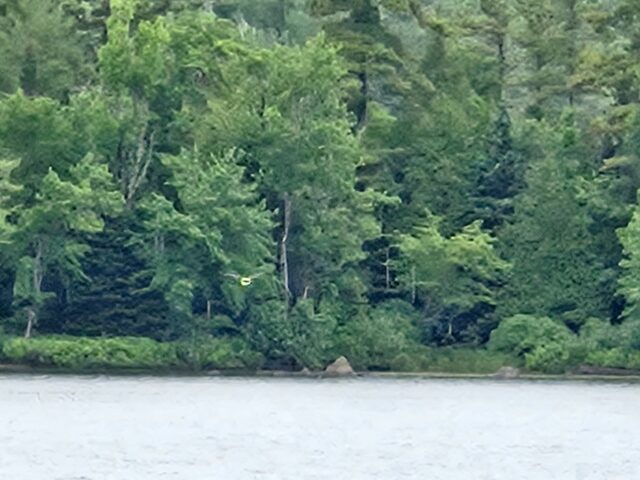Andrew Kniska, SCA Interpretive Ranger
As I drove up to the Great North Woods, I was tired after driving three hours in a rural place I had never been before. I had come down from the White Mountains, a vast expanse of stone and tree that truly makes one feel small and drove into a place that felt far more dominated by nature than man. The forest of spruce and pine and birch was only intercepted by Route 16 and the accompanying Androscoggin River. Deep into the 13-mile forest, I saw something swoop into my view that made me audibly say “oh my god” to myself, something I seldom do. I had seen it a million times, but never before in real life. A Bald Eagle flying above the river, searching for its next target, left me with my mouth gaping.

A picture of an eagle I got… Can you find the eagle?
Bald Eagles have long been of symbolic importance to anyone who has had the fortune to live where they frequent. Native Americans thought them to be messengers from God and used their feathers for religious and spiritual ceremonies. They were a popular choice among the founding fathers, with the notable exception of Benjamin Franklin. Franklin, who despite popular belief never expressed interest in making the national bird a turkey, described the Bald Eagle as “a Bird of bad moral character… a rank coward:”.
Franklin seems to be decidedly in the minority on this opinion. I have found my most popular nature program to be the one I have conducted on the birds up here, in the Great North Woods, with many visitors fascinated by the Bald Eagle. I had even seen one on the lake while talking about the bird during this program. Yet, every time I see one fly by, I am still star struck. Their ability to catch fish is impressive, but another local bird of prey, the Osprey, do this as well. The Eagles’ white, black and yellow color scheme makes them striking, and their sharp ever-watchful eyes accentuate their beauty. So what makes me gasp when I see one? Perhaps it is all of these reasons. I do know that whenever I see one up here, I will stop for quite a while and be staring for a long time.

Franklin, B. (1784, January 26). A Letter on the Society of Cincinnati [Personal communication].
Birds of a Feather: The Afterlives of America’s Eagles. (n.d.). https://www.youtube.com/watch?v=IfyEnNhm_1I
Exploring The Traditional Native American Eagle Symbol. (n.d.). https://49native.com/exploring-the-traditional-native-american-eagle-symbol/

